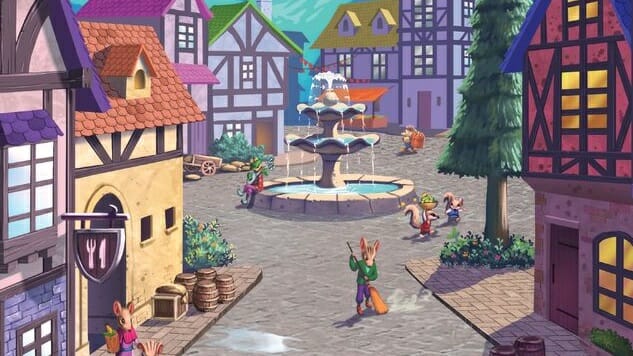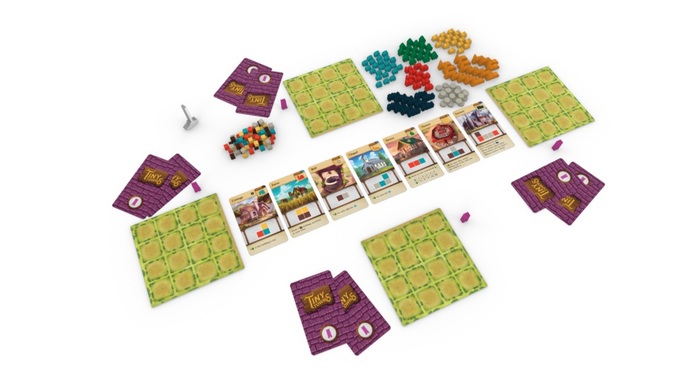The Chaotic City-Building Board Game Tiny Towns Puts You at Your Opponents’ Mercy
Games Reviews board games
Tiny Towns is a citybuilder that gets away from the usual trappings of many Eurogames, where you collect wood and stone and bricks (so, so much wood, and stone, and brick) so you can build stuff. There are resources in Tiny Towns, but instead of collecting piles and piles of cubes in various colors, you’ll just get one cube on each player’s turn, and instead you’ll try to place them on your 5×5 board to match various patterns so you can score more points by game-end. It’s a wide-open game that gives you a ton of choices when play begins, but also gives you the chance to completely box yourself in if you don’t get the resources you need or fail to leave yourself enough space on the board. The result feels a little like Tetris (or games that follow that pattern, like Patchwork or Bärenpark), and a little like the city-builder Quadrapolis, but plays really quickly and puts you more at the mercy of your opponents’ choices.
In every game of Tiny Towns, players will be able to build seven different buildings on their boards—the Cottage is always available, and the other six will vary from game to game, with four choices of buildings in each of six types. The five resources are always the same, but each building has a unique shape and set of resources required to build it. The Cottage, for example, requires that you place a wheat, a glass, and a brick on three contiguous squares on your board to form a right angle. Once you’ve done that, you immediately take a Cottage token, place it on any of those three squares, and remove the resources from your board—which means two of those three spaces are now free for you to use for future buildings. Buildings can take anywhere from two to six resources to build, and you can’t remove a resource once you’ve placed it unless you’ve completed a building.
The catch is that you must take the resources other players choose on their turns, so the more players you have in a game of Tiny Towns, the less control you have, meaning the game is a totally different experience with two players than it is with four or more. On your turn, you name a resource, and every player takes one cube of that resource and must place it, even if they don’t want to do so. With two players, it’s a modest inconvenience, but as the player count rises, it becomes a serious nuisance. You will end up getting resources you don’t want, and have to plan around this inevitability. Two players can play Tiny Towns and chase entirely different buildings and strategies without too much trouble, but with more players, you need to consider what other players might be trying to do and see if you can play along so you don’t end up with a board full of stone you can’t use.
Each building has a specific scoring rule attached to it, often working together with some other buildings on the board or even in specific rows/columns. Your Cottages only score if they’re supplied with food by a Farm or similar building. Taverns and buildings of that type score differently depending on how many of them you’ve built—more is usually better, although one type only scores for you if you have an even number, with a penalty if you end up with an odd number. Some buildings don’t score at all but give you additional benefits, such as the Factory, which lets you choose one resource type and then makes that type a wild-card for the rest of the game, so if another player chooses that resource, you can pick any other resource you want instead.
At the start of the game, each player also gets two Monument cards and chooses one to try to build in that game. Each card is unique, and Monuments can afford you large bonuses or substantially change the rules of the game for you once you’ve built it, such as the Monument that lets you score your unfed Cottages, which should encourage you to build lots of them without worrying about Farms or the like, or the one that lets you place a new building anywhere rather than just on one of the spaces its resources covered. You can play without Monuments if you want a simpler game (perhaps for younger players), but a Monument can do so much to help determine your strategy that I wouldn’t recommend playing without them.
Tiny Towns games take anywhere from 30 to 60-plus minutes depending on your player count; I think 3-4 players is the sweet spot, since you get enough of that factor of your opponents picking resources to force you to think nimbly but not so much that you want to throw your board across the room. The game ends once every player has filled their boards—you’ll probably have a few spaces with resources, which you then remove—and all players score by building type, losing one point for each empty space on their boards. The one flaw here is that it’s too easy for younger players to trap themselves with poor placement early in the game so that they’re stuck well before the game ends, either totally unable to play new buildings or unable to play what they need to score points for their most basic buildings (e.g., finding themselves unable to feed their Cottages). With players under 12 or so, you may want to guide their decisions, or use the variant that allows players to discard up to two resources over the course of the game, so this doesn’t happen. For a slightly more experienced crowd, Tiny Towns is a fun gateway game for two to four players, and a bit of enjoyable madness for up to six.
Keith Law is a senior baseball writer for ESPN.com and an analyst on ESPN’s Baseball Tonight. You can read his baseball content at search.espn.go.com/keith-law and his personal blog the dish, covering games, literature, and more, at meadowparty.com/blog.
